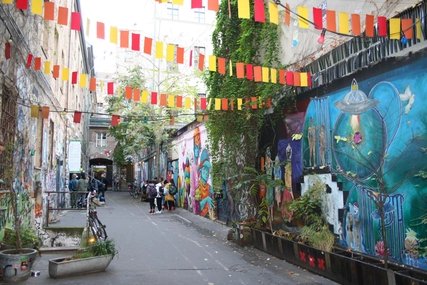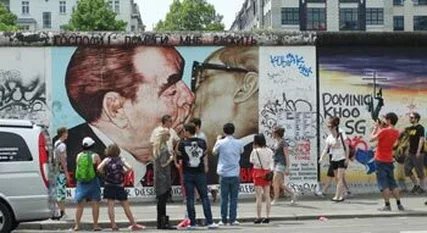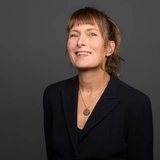
In the 1990s, Berlin was a city in transition. After the fall of the Wall, many buildings are empty and are occupied and revitalised by creative people and free spirits. Derelict houses and industrial wastelands are becoming centres of creative development. Many of these iconic places have survived to this day and preserve the rebellious and experimental spirit of the 90s in Berlin. In this blog, we present 11 places where you can still experience the flair of this exciting time.
Tip: Discover Berlin with our ABOUT BERLIN App. Our multimedia city guide takes you to places where history was made and brings these key moments to life. Now with new tours and highlights related to the fall of the Berlin Wall!
Download for free now.


Tip 1: Kunsthaus Tacheles – A symbol of 90s creativity in Berlin

In the 1990s
In the 1990s, Kunsthaus Tacheles was one of the best-known squatted buildings and a symbol of the creative awakening after the fall of the Berlin Wall. Squatters saved the building, which was scheduled for demolition, and transformed it into a stunning backdrop for alternative art, theater, and installations.
Today
With Fotomuseum Fotografiska, art has moved back into Tacheles. Between stylish bars and perfectly lit exhibition spaces, you can still find graffiti from the squatters' era in the stairwells.
Where: Oranienburgerstraße 54, Mitte
Tip 2: Club der Polnischen Versager - Subversive Art & Culture in Berlin-Mitte

In the 1990s
The Club der Polnischen Versager was founded as a humorous meeting place for Polish migrants in the 1990s, creating a space for cultural and artistic events. Irony and provocation were at the heart of performances, readings, and concerts, which also attracted many Berliners.
Today
The club continues to host a diverse program, retaining the subversive and ironic atmosphere of the 90s, with regular events that emphasize the unconventional character of the venue.
Where: Ackerstraße 168, Mitte
Tip 3: Schokoladen Berlin - An alternative cultural site with a long history

In the 1990s
Chocolate was actually made here from 1911 to 1971. After various interim uses, artists occupied the former chocolate factory in the 1990s, setting up a pub in the front and a theatre in the back. They lived directly above it Right next door, Polish migrants invited people to a tongue-in-cheek artistic exchange in the Club of Polish Failures.
Today
Although the squatters of Schokoladen were able to sign rental contracts for almost all of the space back in 1991, it took until 2012 for the two buildings in Ackerstraße to be secured for the long term. Today, both projects, Schokoladen and Club der Polnischen Versager, offer an exciting contrast to the now rather upscale surroundings and continue to offer an unconventional to subversive cultural and music programme.
Where: Ackerstraße 169, Mitte
Tip 4: E-Werk - a Berlin techno club with worldwide appeal

In the 1990s
The E-Werk was one of the most important techno clubs of the 1990s. Discovered in 1992 by Andreas Rossmann of the Planet Club Crew, the E-former Umspannwerk became one of the central locations for electronic music. At the first party with hard beats in bitterly cold February 1993, there are also open fire installations that you would expect to find in the New York Bronx rather than in the centre of Berlin. Sven Väth, DJ Hell and Paul van Dyk play, Massive Attack come and Prodigy play at the MTV European Music Award 1994 - anything seems possible. At the closing party in 1997, 4,000 guests dance for three days and nights.
Today
Today, the E-Werk is mainly used as an event location and is part of the visitBerlin Convention Office.
Where: Wilhelmstraße 43, Mitte
Tip 5: Kunsthaus Acud - A centre for experimental art since the 90s

In the 1990s
In 1990, the year of reunification, four friends opened the ACUD gallery, named after the first letters of their names, in vacant flats on Rykestraße in Prenzlauer Berg. ACUD quickly became a central location for the independent art scene in Berlin and, following discussions with the Mitte WBM housing association, the Berlin-Mitte district office and various groups, the association was allowed to choose one of 50 vacant residential buildings. Since then, the Acud at Veteranenstraße 21 has offered space for experimental art, theatre, music and film screenings.
Today
The Acud still exists today as an independent cultural centre that carries on the alternative and experimental spirit of the 90s. Here you can see art, go to the cinema and experience a piece of unconventional Berlin.
Where: Veteranenstraße 21, Mitte
Tip 6: Tresor - birthplace of global techno culture

In the 1990s
What must it have felt like back then to climb into the basement of the Wertheim department stores', which had been empty for decades, and find a vault from 1926? One thing was immediately clear to the forefathers of the Berlin techno scene: this is where we're moving in. Three months later, the legendary Tresor opened as the first techno club in Berlin and quickly became an international figurehead for Berlin's techno scene with its hard beats in the rough walls between the broken lockers.
Today
In 2007, the Tresor moved to the former combined heat and power plant on Köpenicker Straße. Some original elements of the old club, such as the lockers, were integrated into the new rooms, which also impress with their rough industrial charm. In addition to techno, you can also find art exhibitions, performances and light shows here today. The Tresor remains an icon of the international techno scene to this day. You can find the original door of the Tresor in Berlin Global, an exhibition at the Humboldt Forum.
Where: Köpenicker Straße 70, Mitte
Tip 7: House of Democracy and Human Rights - a place of political movements in Berlin

In the 1990s
After the fall of the Berlin Wall, the original House of Democracy at Friedrichstraße 165 became an important place for civil rights movements and political discussions. It was handed over to the East German civil movements in December 1989 by the Central Round Table of the GDR from the SED party assets. Many of the most important organisations of the reunification period, such as the Democratic Awakening (DA), the New Forum (NF) and the Initiative for Peace and Human Rights (IFM), moved their offices here and actively helped to shape the political and social upheaval after reunification.
Today
In the 1990s, the "House of Democracy" moved to Greifswalder Straße after a long-standing dispute over ownership rights. When Amnesty International opened its offices there, it was renamed the House of Democracy and Human Rights. To this day, it provides space for political initiatives, NGOs and events and is a centre for political movements and human rights initiatives.
Where: Greifswalder Straße 4, Prenzlauer Berg
Tip 8: Kulturbrauerei - culture and history on the former brewery site

In the 1990s
Like so many other projects, the Kulturbrauerei was not occupied, but the Treuhand took over the dilapidated site of the former brewery after the political change in 1990. Just one year later, the cultural revitalisation began with the founding of "KulturBrauerei gGmbH". The Sat.1 programme "Einspruch" with Ulrich Meyer was produced in the renovated boiler house. Despite many interested parties, the site initially remained unsold until the Treuhandliegenschaftsgesellschaft (TLG) developed a utilisation concept and specified a mix of non-profit and commercial use, including studios, galleries, offices, restaurants and retail. By 1997, two thirds of the space had already been let.
Today
The Kulturbrauerei is still a lively cultural centre with a mix of concerts, markets, restaurants and cultural events. The refurbishment, which was carried out in the 1990s under the supervision of the lower monument protection authority, gives the entire site of the former brewery, whose roots go back to the 1860s, a very special charm.
Where: Schönhauser Allee 36, Prenzlauer Berg
Tip 9: Haus Schwarzenberg - Unconventional art and history in the heart of Berlin

In the 1990s
The Schwarzenberg house, hidden in a courtyard decorated by Street Art right next to the Hackesche Höfe on Rosenthaler Straße, became a symbol of alternative culture in Berlin in the 90s. As it was quickly possible to conclude a usage agreement here, a protected space for Berlin's creatives and free spirits was established, who still realise their ideas here today as an association.
Today
In addition to the Neurotitan and other galleries, the Kino Central, the Monsterkabinett with its automaton creatures and the former club bar Eschschloraque Rümschrümp, which still hosts parties and concerts today, you will also find the Anne Frank Centre in the backyard. To this day, Haus Schwarzenberg is a centre for unconventional art and culture in which the past, present and future merge.
Where: Rosenthaler Straße 39, Mitte
Tip 10: Kunstmeile Auguststraße - Where Berlin's contemporary art history began

In the 1990s
After the fall of the Berlin Wall, Auguststraße became a centre of the Berlin art scene. After reunification, numerous galleries and studios moved into the vacant buildings here and the street became a creative melting pot. Places such as the Kunst-Werke (KW), which Klaus Biesenbach founded in 1991 together with a group of students in a former, dilapidated margarine factory, played a central role in the new Berlin art movement. The listed building was gradually renovated in the 1990s and turned into exhibition space. Another highlight is the iconic Café Bravo glass pavilion in the inner courtyard, which was designed by US artist Dan Graham.
Today
The KW Institute for Contemporary Art in Berlin still exhibits contemporary art today. KW is also still the home of the Berlin Biennale, which has been presenting contemporary art and experimental formats at various locations in Berlin every two years since 1996. The next and 13th Berlin Biennale will take place from June to September 2025 and will be curated by Zasha Colah.
Where: Auguststraße 69, Mitte
KW Institute for Contemporary Art
Tip 11: East Side Gallery - art & history united on the longest piece of the Berlin Wall

In the 1990s
The East Side Gallery was built in 1990, shortly after the fall of the Berlin Wall. Artists from all over the world painted the longest remaining section of the Wall, which stretches along the Spree. The 1.3-kilometre-long open-air gallery became a symbol of freedom, hope and overcoming the Cold War. Works of art such as the famous "Brotherly Kiss" painting by Dmitri Vrubel are now world-famous and part of the collective memory of reunification.
Today
The East Side Gallery is not only a monument, but also one of the most visited sights in Berlin. The artworks have been restored in recent years and the wall attracts thousands of visitors every day who want to discover the heritage of the 1990s and the history of the city.
Where: Mühlenstraße, Friedrichshain





